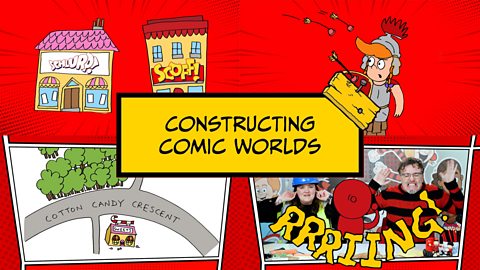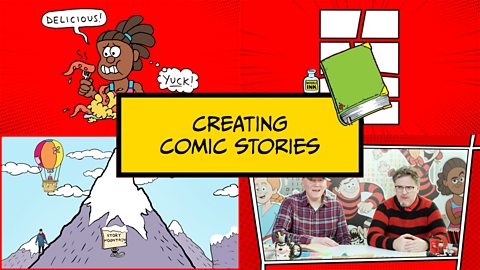Mike: My name's Mike and I'm Director of Mischief at Beano.(trumpet toots)
And this is Ed.
Ed is an artist.
Ed: Hi, I'm Ed and I draw characters and backgrounds in comic books.
(trumpet toots)
Mike: Today we're going to show you how to create your very own comic character. With a single great character you can tell all sorts of stories and not just comic book stories.
You can put your character in a movie.
Ed: Or a play.
Mike: Or even in a video game.
When you create a character, before you worry about what they look like on the outside, let's think about who they are on the inside.
Let's create a simple character brain cloud - it's easy.
You start by drawing a cloud shape. (pen scribbles)
So, ask your character some questions in your imagination and write their answers inside the thought balloon.
So, for my character I'm going to ask them what they like from my imagination.
My character likes cheese and my character picks their nose.
My character's scared of baths.
If you write them all down inside the brain cloud, you can use it as a quick guide to check what your character might think or do in any situation.
Now it's time to draw your character.
A good way to start is to create a simple stick person.A stick person makes an awesome character.
Once you've drawn your stick character, you can add details to complete their look like hair and clothes and accessories. (pen squeaks)
Now, if we want to, we can use our stick character as a guide to make amore developed character.
Ed: And anyone can do this.
You don't have to be a comic book artist to draw a comic book character.
In fact, it's better if you do it in your own style. Start with a head shape.It could be a circle, a triangle, it could be spiky.
Mike: I know, what about a fried egg?
Ed: Eyes and eyebrows can show emotion.
Remember to leave space for the eyebrows.
So, get emotional with angry eyes, sad eyes, hypnotic eyes, shocked eyes, and…
Mike: Cyclops!
Time to pick a nose. Get it, pick a nose.
Ed: Letters of the alphabet make great nose shape starters. O, U, J.
Mike: How about an M for Mike? Mega-mouth.
Ed: Emojis are a great inspiration.Try a toothy mouth. A mouth with big lips.
It helps to make the expression you're drawing to put you in the mood.
Mike: When you're happy with your sketch, why not create your character using other art stuff.
Ed: Like charcoal, charcoal's really good for shading.
Mike: Charcoal.
Ed: Or add some colour with paint.
Mike: Paint.
Ed: Or add an extra dimension by sculpting in 3D using clay.
Mike: The best character names reveal personality, backstory and talent. Like Billy Whizz!
Ed: He's really fast.
Mike: Try adding an adjective - a describing word - in front of your own name.
So I could be Fun Mike.
Ed: And I could be Arty Ed.
Mike: You can make your character name even better too, by using something called alliteration.
Alliteration is where you put two words next to each other that start with the same sound, like Mischievous Mike, or Mike the Magnificent.
Ed: Or Messy Mike.
Mike: Who you calling messy?! (trumpet toots)
You can also make the adjective rhyme with the name, like our famous character, Roger the Dodger.
Ed: And it fits because he's always dodging hard work.
Mike: Always remember to think about your character's personality traits when you're coming up with names. We decided to call our character…
Ed: Cheesy Charlie!
Mike: So that's our guide to creating comic characters.
Start with your brain cloud to invent your character's personality.
Draw your stick person to plan the look of your character.
Use the stick person as a guide to develop your more detailed drawing, painting or sculpture.
And finally, give your character a descriptive name.
Video summary
Beano's Mike ('Director of Mischief') and Ed (Artist) demonstrate how to create your own comic character.
They begin by using a 'brain cloud' to explore a character's personality and interests, before drawing their character using a stick person shape as a guide. It doesn’t have to be a stick person of course; it could be a stick alien, a stick animal, a stick creature, a stick anything!
Once a stick base is established, Mike and Ed explore various head shapes, before adding eyes and eyebrows to show emotion.
Throughout the video, Mike and Ed encourage pupils to add details to explore their character further and create a more developed character.
Finally, they explore onomatopoeia, alliteration and rhyme to create a list of potential names for their character. Pupils learn that the best character names reveal backstory, personality and talent - an example being the Beano character ‘Billy Whizz’.
This short film is from the BBC Teach collection Beano: How to create a comic.
Teacher Notes
Task: Brain Cloud
In this task, pupils are encouraged to ask their characters questions, which they then answer to create a thought bubble. Provide your children with a thought bubble.
- Start by coming up with a list of questions as a class, e.g. ‘What is your favourite food?’, ‘Do you have any hobbies?’, ‘Do you have any bad habits?
- Model how to record answers in your thought bubble, e.g. “I like cheese!”, “I pick my nose” (see video). Encourage children to come up with a range of funny/silly answers and share ideas as a class.
- Click here for thought bubble template (PDF 1.1MB)
Ideas for differentiation:
- You might provide younger pupils with a list of questions to answer or challenge older children to explore deeper aspects of character, which can then be shown through their drawings in parts 2 and 3.
- This could also be extended into a writing opportunity. Younger pupils might record using simple sentences and conjunctions (because, and so), whereas older children could use a range of conjunctions to explain their ideas. Pupils in Upper Key Stage 2 could be encouraged to use sophisticated vocabulary and punctuations e.g. semicolons and brackets/dashes for parenthesis.
Task: Stick Person
In this task, pupils create their character, using a stick person as a guide.
- Model how to draw a simple stick person before children draw their own.
- Add details such as hair, clothes and accessories. Encourage pupils to be creative with the accessories they add. Could they add accessories which are important or special to them?
Ideas for differentiation:
- You might provide younger children with a blank stick person to add detail to.
- Click here for a stick person template (PDF 1.1MB)
Task: Detailed Character
In this task, pupils add detail to their stick character through exploring head shape and facial features.
- First, model choosing a head shape (circle, triangle, square, even a fried egg!). Encourage pupils to be as creative as possible.
- Next, choose an eye shape. Encourage pupils to use their eye shape to show emotion e.g. angry eyes, sad eyes. Remember to leave space for the eyebrows.
- Then, children ‘pick a nose’ using letters of the alphabet and a mouth using emojis as inspiration. Encourage pupils to make the expression they want to create before drawing, the sillier the better.
- Finally, pupils can explore adding further detail using different media, for example, charcoal, paint or even clay.
Ideas for differentiation:
- You might provide a head shape for less confident artists, or support with drawing when completing the task. Pupils who are more confident should be encouraged to explore a range of different head shapes and facial expressions, before choosing their favourite.
- Click here for head shapes template(PDF 1.2MB)
Task: Name your creation
In this task, pupils explore a range of techniques before coming up with a name for their character.
- Present pupils with a range of names from the Beano e.g. ‘Roger the Dodger’, ‘Billy Whizz’, ‘Desperate Dan’ and ‘Dennis the Menace’. What do these names tell us about the characters? Why do they make effective names? Reveal that they explore backstory, personality and/or talent.
- Explore onomatopoeia and alliteration as a class. What do these terms mean? How can we use them to create names?
- Next, explore ‘Roger the Dodger’ and ‘Dennis the Menace’. What technique has been used here? Can we come up with our own?
- Come up with a list of examples as a class e.g. ‘Wendy Whoosh’, ‘Silly Sarah’, ‘Mean Mark.’
- Encourage children to use one from the list already created or come up with their own to name their character.
Ideas for differentiation:
- Younger children might stick to adding adjectives, or using alliteration as a challenge. Older children should be encouraged to use onomatopoeia or rhymes.
Click here for downloadable version of all teacher notes for this series. (PDF, 728KB)
This series is suitable for teaching English and Art and Design/Expressive Arts at Key Stage 2, 2nd Level, and Progression steps 2 and 3 across the UK.
Constructing comic worlds. video
Learn about comic book settings and how to create a world for characters.

Creating comic stories. video
How to create a comic book story using a three-act story mountain structure.
